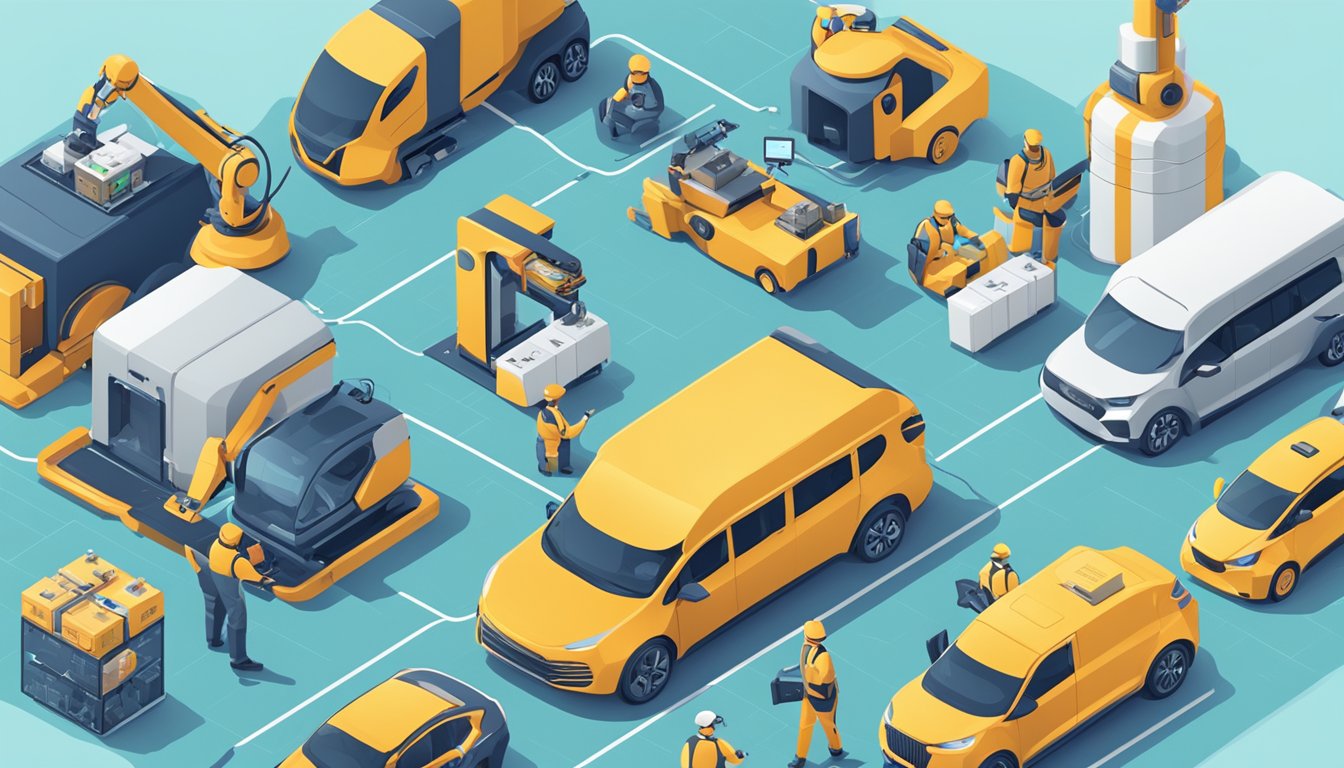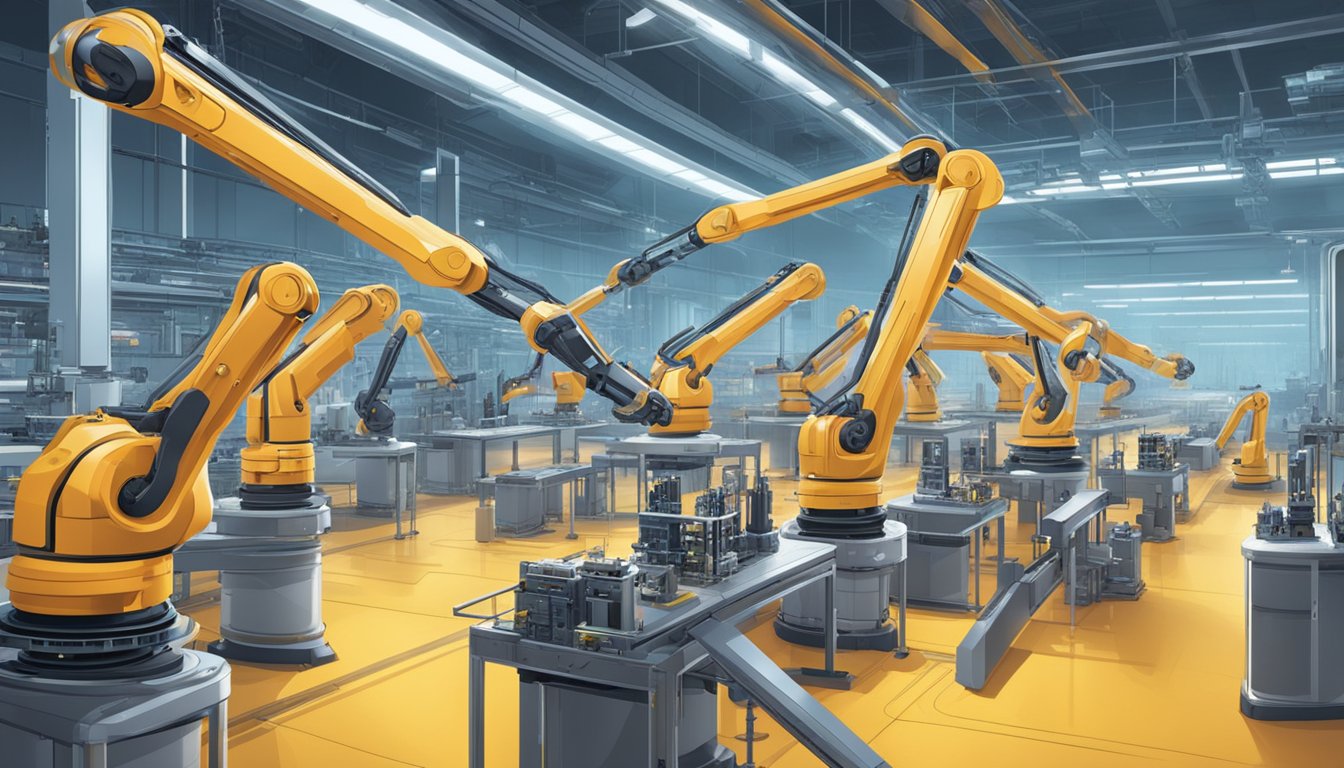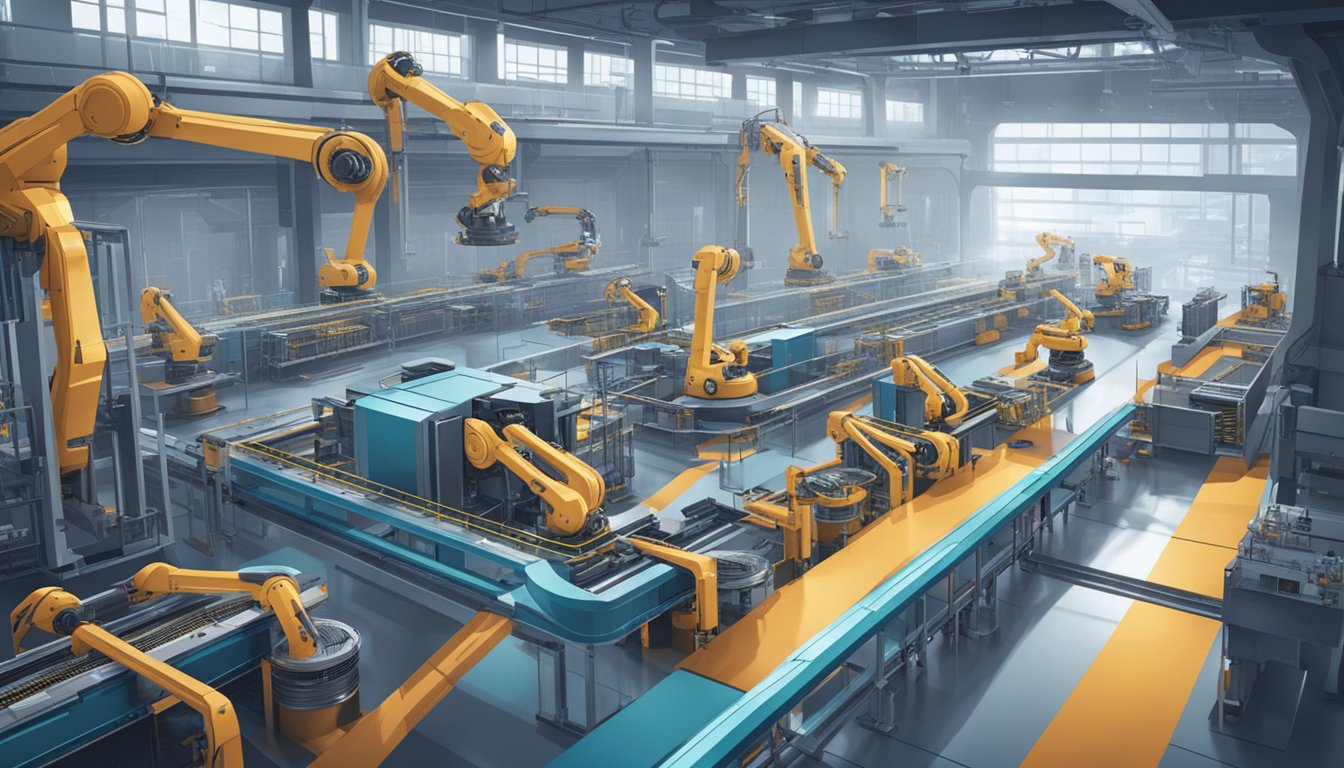Staying Ahead with AI Automation Trends: Mastering the Future of Efficiency
Have you ever felt like keeping up with the latest trends in technology is a bit like trying to drink from a firehose? Well, breathe easy, because when it comes to understanding how artificial intelligence (AI) and automation are revolutionizing the way we work, you’re in the right place. To say that AI and automation technologies are transforming industries would be an understatement. From boosting operational efficiencies to personalizing customer experience, these technologies are not just the future – they are the prevailing winds that are steering the present.

But what does staying ahead of the curve with AI automation actually entail? Think of AI as your digital sidekick, tirelessly working behind the scenes to make your job easier. Whether it’s intelligent algorithms optimizing logistics or chatbots charming your customers, AI is donning many hats and excelling in each role. And let’s talk numbers because they tell a powerful story: according to a Forbes article, the average number of AI capabilities that organizations use has soared, hinting at a growing embrace of AI-powered solutions across various functions.
So, how can you ride this wave effectively? It’s not just about jumping on the bandwagon; it’s about understanding automation trends that are relevant and can provide a tangible boost to your business. Consider, for example, the shift towards generative AI, which is as game-changing as it sounds and can reframe the way you approach content creation or design. It’s an exciting time to be at the forefront of AI and the rewards for those who leverage its full potential are as real as they get. Stay tuned as we break down what trends are shaping the AI automation landscape and how they can add that extra zing to your organization’s performance.
The Evolution of AI and Automation in Business
In recent times, you’ve probably noticed that AI and automation are revolutionizing the way we do business. It’s like we’ve hopped into a time machine and zipped from the days of paper filing to smart algorithms making decisions in the blink of an eye!
Historical Milestones and Predictions
We’ve come a long way since the first seeds of AI were planted. Remember the excitement when IBM’s Deep Blue beat chess grandmaster Garry Kasparov in 1997? That was a game changer—literally. Fast forward to our current landscape, and it’s clear that AI is no longer just a fancy add-on. It’s a core component of business strategy. Various industries have embraced AI with open arms, and according to a report, the global AI market is set to soar at a CAGR of 37.3% from 2023 to 2030. With AI, today’s business leaders can dive into data like never before, crafting strategies backed by deep insights.
| Year | Milestone |
|---|---|
| 1997 | IBM’s Deep Blue defeats Garry Kasparov |
| 2023-2030 | Expected CAGR of global AI market: 37.3% |
The Role of AI in Modern Enterprises
Modern businesses and AI? They’re a match made in tech heaven. AI wears many hats in an enterprise setting—it’s your customer service whiz, your data analyst, and your strategic advisor. It boosts efficiency and productivity, letting companies focus on scaling new heights while the bots handle the grunt work. Imagine having a personal assistant who understands your customers as well as you do—that’s AI for you.
Enterprises are hopping on the AI bandwagon at warp speed, and it’s not just the tech giants. Even your local bakery could be using AI to predict the next big cupcake trend. Gartner even went on record saying that AI technologies will be virtually pervasive in almost every new software product by 2020—talk about a ringing endorsement from the tech oracle themselves!
- Enterprise Adoption: From startups to Fortune 500s, everyone’s in the game.
- Gartner’s Prediction: AI, a staple in almost all forthcoming software.
Ready to power-charge your business with AI? It’s not just about keeping up—it’s about staying ahead. And remember, you’re not alone in this; business leaders everywhere are making the leap. So, why not you?
Current Automation Trends in Key Industries

Have you noticed how industries you interact with every day are changing? Let’s dive into the specifics and explore the latest trends in key sectors that are reshaping the business landscape.
Trends in Healthcare
In healthcare, AI-driven predictive analytics are transforming patient care. Hospitals are now harnessing real-time data to predict patient admissions and staffing needs, leading to more efficient operations. For example, Generative AI is aiding in drug discovery by rapidly generating viable compounds and reducing the time to market for new treatments.
Innovative Automation in Manufacturing
Think robots when you think of manufacturing. The trend towards Digital worker-first processes isn’t science fiction; it’s here. Manufacturers are increasingly deploying collaborative robots that work alongside humans to enhance efficiency and safety. IoT and predictive maintenance are drastically reducing downtime, with sensors providing real-time feedback to preemptively address machinery issues.
Retail Transformation Through AI
Ever wondered why your shopping experiences seem so personalized? Retailers are leveraging AI to tailor recommendations and optimize inventory levels based on your buying habits. The push towards a Digital worker-first process in retail means that from stocking shelves to forecasting trends, automation is behind the scenes making sure you find exactly what you’re looking for.
AI Disruption in Finance and Banking
Banks aren’t just about vaults and tellers anymore. AI disruption in finance leads to advanced algorithmic trading, risk management, and personalized customer service chatbots. Ethical automation and ESG compliance are becoming central as institutions seek to align their operations with sustainability goals. Moreover, security in this sector is tighter than ever with the integration of advanced cybersecurity measures to protect your financial data.
Scaling Business with AI
As businesses aim for the stars, AI acts as the rocket fuel for growth and scalability. Are you ready to watch your business soar?
Incorporating AI into Growth Strategies
Ever wondered how AI can be your ultimate growth partner? Imagine having a virtual genie that not only understands your customers but predicts their needs. The secret sauce to scaling businesses lies in leveraging AI to analyze data and driving strategic decisions. It’s not just about having the technology, it’s about integrating it smartly into your growth strategy.
- Understand customer behavior with AI-powered analytics.
- Predict market trends to stay ahead of the competition.
This isn’t just a prediction; it’s what’s happening now. AI is transforming how you explore new markets and how effectively you can respond to changing consumer demands.
Managing Workforce and Learning new Skills
Here’s the thing: AI doesn’t mean bidding farewell to the human touch. It’s about enhancing the workforce with new skills that complement AI’s capabilities. It’s a dynamic duo of human and machine, where one fills in the gaps for the other.
- Retrain your team to work alongside AI, turning them into savvy knowledge workers.
- Focus your team’s efforts on tasks that require a personal touch, while AI handles data-driven tasks.
By adopting AI-powered automation, businesses streamline complex processes and create room for employees to grow their skillset. This isn’t just about efficiency; it’s about empowering your team and driving business growth simultaneously.
Improving Efficiency and Productivity

Hey there! Ready to boost your efficiency game? Let’s dive into how AI and RPA are total game-changers in streamlining your work life.
AI in Streamlining Workflows
Ever feel like you’ve got too much on your plate? AI’s here to lend a hand in the workflow department. By applying smart algorithms, AI systems can prioritize tasks, automate the mundane, and cut down the noise. Imagine your to-do list getting sorted before you’ve even had your first coffee – sweet, right?
- Task prioritization: AI can weigh project urgencies and deadlines, ensuring you focus on what’s hot.
- Automation of routine tasks: From scheduling to sorting emails, AI’s got it covered.
- Noise reduction: By filtering out irrelevant info, you get to lock in on what truly matters.
RPA and Business Processes
What if I told you robots could be your new coworkers? We’re talking Robotic Process Automation (RPA), where the robots are software and they’re here to make business processes a breeze! RPA handles repetitive tasks with a level of precision that’s, well, robotic.
- Advantages of RPA:
- Accuracy: Say goodbye to human error!
- Speed: Tasks that took hours? Done in minutes.
- Cost-effective: Robots don’t need coffee breaks or vacation days.
Here’s the skinny: integrating RPA means you’re delegating the dull stuff, so you can shine where it counts.
Ready to up your efficiency game? AI and RPA are your ticket to a smoother, smarter work life. Get on board and watch your productivity soar!
Innovations in AI Automation

As we embrace the ever-evolving world of technology, you’re probably wondering how AI is shaking things up, right? Let’s cut to the chase and explore the freshest slices of innovation that are making waves in the AI automation landscape.
Generative AI
Have you heard the buzz about Generative AI? It’s like the cool new artist on the block but with circuits and code. This tech is no one-trick pony; it can whip up everything from realistic images to creative written content that could even fool you into thinking it’s human-made. Imagine having a virtual Picasso at your fingertips!
- Capabilities: Creates original content
- Applications: Art, music, writing, design
Natural Language Processing
NLP—you’ve probably chatted with it and didn’t even realize it was AI, right? It’s that good at understanding human language. From audio transcription to chatbots that don’t sound like robots, NLP is helping computers get what you’re saying, both verbally and in writing.
- Functions: Comprehension, interaction, translation
- Improvements: Better context understanding, sarcasm detection
Advancements in Machine Learning
Now, let’s talk about ML. It’s the behind-the-scenes whiz that learns from data without being explicitly programmed—pretty smart, huh? It’s evolving so fast, unleashing new possibilities in predictive analytics and personalized experiences.
- Recent Breakthroughs: Enhanced predictive models, self-learning systems
- Impact: Personalization, efficiency, decision-making
Remember, you’re at the heart of this tech revolution, steering the ship towards a future where AI helps you make art, chat effortlessly, and even predict the tea leaves of your data. Keep an eye on these trends; they’re not just changing the game, they’re transforming the way you interact with the world.
Implementing Automation: Challenges and Solutions

Before jumping into the world of automation, it’s essential you’re aware of not just the game-changing advantages but also the real challenges you might face. Let’s zero in on how to tackle these concerns with practical solutions, ensuring your journey is as smooth as possible.
Addressing Ethical AI Concerns
Have you considered the ethical implications of the AI you’re deploying? Well, you should! You’re not alone in wondering how to align AI with ethical values. To resolve this, companies need to design AI with transparency in mind and ensure decision-making processes are explainable and fair. According to UiPath, involving ethical guidelines is a crucial part of the AI implementation strategy.
Navigating Digital Transformation
So, you’re ready to transform digitally? Bravo! It’s a thrilling ride, but not without its hurdles, like resistance to change or integration issues. The key is to embrace technology at a pace that suits your organization. Start small, earn quick wins, and scale up. As McKinsey & Company advises, it’s about tailoring the transition to both the business and its people.
Regulations and Governance
When it comes to regulations and governance, staying compliant is non-negotiable. Are you aware of the latest laws regarding automation in your industry? Whether it’s data protection, industry standards, or operational compliance, getting ahead of regulations can save you from a lot of headaches down the line. As pointed out by Blue Prism, having good governance around AI usage is as important as the technology itself.
Remember, whether it’s ethical dilemmas, the transformation journey, or regulatory compliance, approaching these challenges with well-thought-out strategies and solutions will not just help you stay ahead but also turn potential obstacles into stepping stones for success.
Measuring the Impact: Analytics and ROI
When it comes to AI automation, understanding the return on investment (ROI) and analytics is like putting a high-powered microscope on your business outcomes. It’s about seeing clearly how your automation investments are really performing. Let’s unwrap the mystery of metrics and money!
Success Metrics in Automation Projects
Hey there, have you ever wondered if you’re cheering for the right team when evaluating your automation projects? It’s crucial to set the success metrics that truly reflect your project’s performance.
- Time to Value: How quickly does the automation start improving processes?
- Accuracy Improvement: Are fewer errors popping up post-automation?
- Employee Productivity: Is your team able to tackle more strategic tasks?
Consider these as your winning trifecta. Companies leading in automation witness substantial improvements like these, translating into tangible benefits. For instance, top-tier organizations report an impressive payback period of as little as 1.2 years compared to 1.6 years for beginners in automation as per insights from Deloitte Insights.
ROI and Business Outcomes
Dollars and sense, right? The ultimate goal of injecting AI into your workflow is to enhance business outcomes. But how do you measure it without getting tangled in data?
- Cost Savings & Revenue Growth: Track the straight-up financial gains. Are you spending less and making more?
- Customer Satisfaction: High-tech automation should lead to happier customers.
To grasp the ROI for artificial intelligence, consider both direct and indirect financial impacts. Direct impacts can be seen in increased revenues or reduced operational costs, while indirect impacts might include improved customer satisfaction leading to higher retention rates. A PwC article discusses AI’s ROI challenge and suggests that despite the high initial investment, AI solutions can lead to substantial long-term benefits if properly implemented and measured (PwC).
Remember, measuring ROI isn’t just about the numbers—it’s about understanding how those numbers affect your business today and in the future. Keep an eye on these indicators, and you’ll be navigating the AI automation landscape like a pro!
The Future of AI Automation
The landscape of AI automation is rapidly transforming, and keeping up with its evolution is crucial for staying competitive in various sectors. From increased investment to more sophisticated autonomous vehicles, let’s explore what’s on the horizon and how you can prepare for these advances.
Predicting Upcoming AI Trends
What’s next for AI, and how will these advancements impact your industry or business? Well, experts anticipate that AI trends will favor practical applications that make everyday life and business operations more efficient. For instance, a report by MIT Technology Review suggests that generative AI models will likely become more accessible to non-technical users, sparking innovation across various fields. Investment in AI is surging, aiming to drive growth and efficiency. Expect to see a significant push towards personalized AI-based solutions that can adapt to your unique challenges, creating a more efficient and productive future.
Preparing for Autonomous Technology
Are you ready for a world where autonomous vehicles are the norm? The automation and AI trends indicate that industries are gearing up to embrace this reality with open arms. Preparation today involves understanding the capabilities of autonomous technology and investing in the right areas to leverage them tomorrow. As we peer into the future, it’s clear that AI-driven autonomy is not just about vehicles; it encompasses a broad spectrum of applications in manufacturing, service industries, and beyond. Being proactive now means you’re setting yourself up for success in an automated future.
Keep an eye on the unfolding AI automation scenario, and don’t hesitate to hop on the trend train. After all, it’s moving fast, and you don’t want to be left behind, do you?
Frequently Asked Questions
Navigating the ever-evolving landscape of AI automation can be tricky, but getting a grip on how it affects various facets of the business world is crucial. Let’s dive into some common inquiries to clarify how embracing AI automation can be a game-changer for your company.
How can businesses integrate AI automation to improve efficiency?
By leveraging AI automation, businesses streamline complex tasks, reduce human error, and accelerate decision-making processes. It’s about identifying repetitive tasks and applying AI automation solutions to enhance workflow and free up your team for more creative endeavors.
What are the benefits of adopting AI automation early in various industries?
Early adoption of AI automation puts industries ahead of the curve by fostering innovation, driving efficiency, and providing a competitive edge. It not only improves business processes but can also lead to significant cost savings and increased revenue through improved service delivery and operational agility.
In what ways will AI automation impact the future job market?
AI automation is set to shift the job market by transforming existing roles and creating new ones, especially in fields that manage, develop, and implement AI solutions. Workers will need to cultivate digital skills to stay relevant, as routine tasks become automated and the demand for technological fluency increases.
What strategies can professionals use to adapt to AI-driven workplaces?
Professionals can stay ahead in AI-driven workplaces by upskilling in tech-rich domains, embracing a mindset of continuous learning, and staying updated with the latest AI trends. Networking within tech communities and attending relevant workshops can also be beneficial in adapting to these changes.
What are some ethical considerations when implementing AI automation?
Ethics in AI automation revolve around transparency, privacy, and fairness. It’s essential to consider the implications of data usage, prevent biases within AI algorithms, and maintain accountability for the AI’s decisions. Ethical implementation also involves ensuring that automation does not lead to significant societal disparities.
How will AI automation affect customer service and satisfaction levels?
AI automation has the potential to revolutionize customer service by providing personalized experiences and instant support. Automated systems can quickly analyze vast amounts of data to understand customer preferences and behavior, leading to higher satisfaction levels and loyalty as customers receive tailored assistance and fast resolutions to their inquiries.








